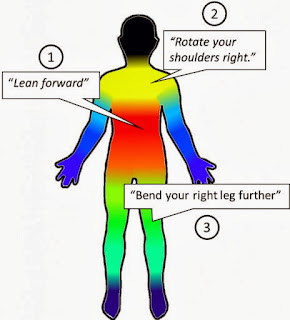"Eyes-free Yoga" for blind and low-vision people, Microsoft Kinect based program

Yoga is a physical, mental and spiritual exercise that gets you rid of anxiety, stress, depression and brings peaceful state in your life. Lately in a conference SIGACESS International conference of computing and accessibility in Bellevue Wash, on 21 Oct, 2013 students of University of Washington presented a unique and unprecedented technology for blind and low-vision people to do yoga practice by means of auditory feedback called "Eyes-free Yoga". A small team of UW Kyle Rector who's pursuing doctoral degree in computer Science and Engineering faculty coded a program based on geometry and law of cosines which she associated with Kinect device of Microsoft. Program instructs the Kinect device to read user's body angles. Kinect is a device by Microsoft which deals with motionery sensors in Xbox 360 video game console and Windows PCs. There are six typical class poses (exercises) that Eyes-free Yoga can guide the blind or low-vision users, such as Warrior 1 and 2, Tree, Chair pose etc.

This technology reads the central area of the body and gives auditory feedback to confirm either the user's alignment is correct or not, after this Eyes-free yoga proceeds to head, neck, arms an in last legs. Julie Kientz a UW assistant professor in Human Centered Design and Engineering and Cynthia a research assistant in Computer Science and Engineering worked with Rector in this project, they believe that Eyes-free yoga can transform a typical visual activity into something that blind can also enjoy. "I see this as a good way of helping people who may not know much about yoga to try something on their own and feel comfortable and confident doing it," Kientz said. "We hope this act is a gateway to encouraging people with visual impairments to try exercise or broader scale."

Since Rector wasn't the yoga instructor that's why she met many yoga instructors and mentors to understand the exact alignment positions. When Rector accomplished Eyes-free yoga program, she herself practiced and made the mistakes deliberately to examine the performance of Eyes-free yoga. She was quite satisfied with the results of this technology. "I tested it all on myself so I felt comfortable having someone else try it," she said. Having tested herself she gathered 16 blind and low-vision people in which some were layman about yoga, some were with little experience of yoga exercises and some were regular yoga class pupils. Thirteen (81%) of 16 said they would recommend to let the people know about this handy program.
Rector and her partners chalked out to make it available on the internet open source , however there isn't any further updates about launching. I will post about it my next post as soon as I get further information about Eyes-free yoga.
Thank you very much friends.
Rector and her partners chalked out to make it available on the internet open source , however there isn't any further updates about launching. I will post about it my next post as soon as I get further information about Eyes-free yoga.
Thank you very much friends.




0 comments:
Post a Comment